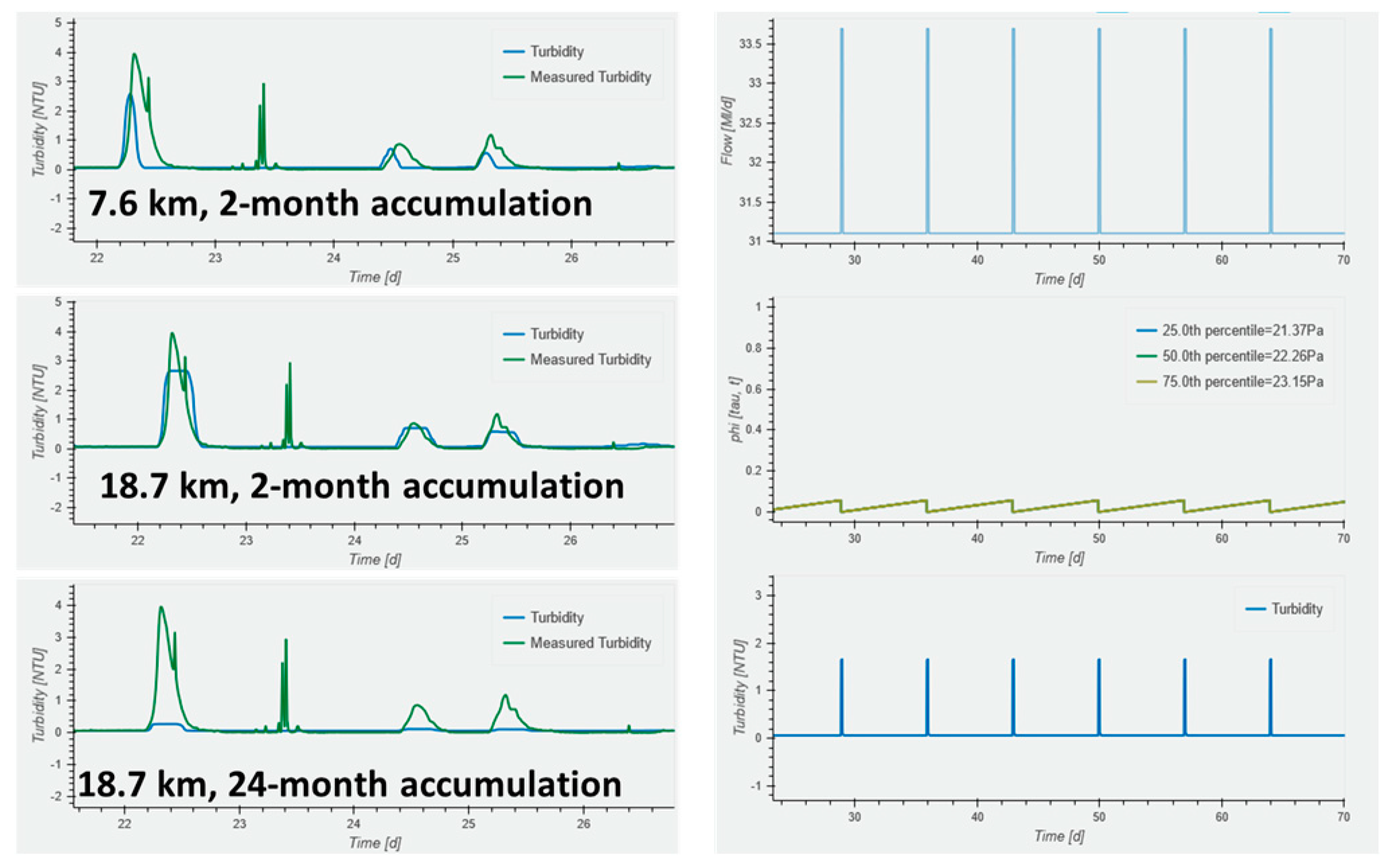Raw Water Main Flow Conditioning to Manage Material Load and Treatment Capacity †
Abstract
1. Introduction and Background
2. Materials and Methods
2.1. Study Site
2.2. Flow, Turbidity, and Iron
3. VCDM Calibration and Discussion
4. Conclusions
Author Contributions
Funding
Institutional Review Board Statement
Informed Consent Statement
Data Availability Statement
Acknowledgments
Conflicts of Interest
References
- Boxall, J.; Blokker, E.J.M.; Schaap, P.G.; Speight, V.; Husband, S. Managing discolouration in drinking water distribution systems by integrating understanding of material behaviour. Water Res. 2023, 243, 120416. [Google Scholar] [CrossRef]
- Sunny, I.; Husband, S.; Boxall, J. Simulating long term discolouration behaviour in large diameter trunk mains. Environ. Sci. Water Res. Technol. 2023, 9, 756–771. [Google Scholar] [CrossRef]
- Furnass, W.R.; Collins, R.; Husband, S.; Sharpe, R.L.; Mounce, S.; Boxall, J. Modelling both the continual erosion and regeneration of discolouration material in drinking water distribution systems. Water Sci. Technol. Water Supply 2014, 14, 81–90. [Google Scholar] [CrossRef]
- Husband, S.; Boxall, J. Understanding and managing discolouration risk in trunk mains. Water Res. 2016, 107, 127–140. [Google Scholar] [CrossRef] [PubMed]
- Blokker, E.J.M.; Schaap, P.G. Particle accumulation rate of drinking water distribution systems determined by incoming turbidity. Procedia Eng. 2015, 119, 290–298. [Google Scholar] [CrossRef]
- Fish, K.; Reeves-McLaren, N.; Husband, S.; Boxall, J. Unchartered waters: The unintended impacts of residual chlorine on water quality and biofilms. NPJ Biofilms Microbiomes 2020, 6, 34. [Google Scholar] [CrossRef] [PubMed]



Disclaimer/Publisher’s Note: The statements, opinions and data contained in all publications are solely those of the individual author(s) and contributor(s) and not of MDPI and/or the editor(s). MDPI and/or the editor(s) disclaim responsibility for any injury to people or property resulting from any ideas, methods, instructions or products referred to in the content. |
© 2024 by the authors. Licensee MDPI, Basel, Switzerland. This article is an open access article distributed under the terms and conditions of the Creative Commons Attribution (CC BY) license (https://creativecommons.org/licenses/by/4.0/).
Share and Cite
Husband, S.; Walkington-Mayo, N.; Boxall, J. Raw Water Main Flow Conditioning to Manage Material Load and Treatment Capacity. Eng. Proc. 2024, 69, 193. https://doi.org/10.3390/engproc2024069193
Husband S, Walkington-Mayo N, Boxall J. Raw Water Main Flow Conditioning to Manage Material Load and Treatment Capacity. Engineering Proceedings. 2024; 69(1):193. https://doi.org/10.3390/engproc2024069193
Chicago/Turabian StyleHusband, Stewart, Neil Walkington-Mayo, and Joby Boxall. 2024. "Raw Water Main Flow Conditioning to Manage Material Load and Treatment Capacity" Engineering Proceedings 69, no. 1: 193. https://doi.org/10.3390/engproc2024069193
APA StyleHusband, S., Walkington-Mayo, N., & Boxall, J. (2024). Raw Water Main Flow Conditioning to Manage Material Load and Treatment Capacity. Engineering Proceedings, 69(1), 193. https://doi.org/10.3390/engproc2024069193





